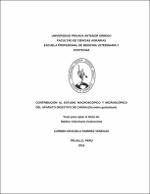Mostrar el registro sencillo del ítem
Contribución al estudio macroscópico y microscópico del aparato digestivo de cañan (Dicrodon guttulatum)
| dc.contributor.advisor | Lombardi Perez, Cesar Leopoldo | |
| dc.contributor.author | Ramirez Venegas, Carmen Graciela | |
| dc.creator | Ramirez Venegas, Carmen Graciela | |
| dc.date.accessioned | 2017-09-11T15:51:11Z | |
| dc.date.available | 2017-09-11T15:51:11Z | |
| dc.date.issued | 2017 | |
| dc.identifier.uri | https://hdl.handle.net/20.500.12759/2948 | |
| dc.description.abstract | La presente investigación se realizó en el cañán ( Dicrodon guttulatum ) , una especie de reptil del género Dicrodon, distribuido específicamente en el territorio peruano, el cual se encuentra habitando los desiertos secos de la zona norte del Perú, extendiéndose por Jequetepeque, San Pedro de Lloc, Virú, entre otros y que actualmente se encuentra identificado como una especie en peligro de extinción con pocos estudios específicos respecto a su anatomía, fisiología, entre otros. Los especímenes fueron colectados de un vendedor de este reptil para el consumo humano en el Distrito de San Pedro de Lloc, provincia de Pacasmayo, los cuales se eligieron al azar y fisiológicamente sanos; se obtuvieron muestras histológicas del sistema digestivo y se tiñeron con colorante de hematoxilina y eosina, para lograr identificar las diferentes estructuras histológicas ya que no hay ninguna literatura específica para este estudio y en esta especie. En los resultados se han evidenciado que las estructuras como: Lengua, esófago, estómago, intestino delgado, intestino grueso, páncreas e hígado no presentan cambios histológicos respecto a las demás especies en mención. | es_PE |
| dc.description.abstract | This research was conducted in Canan ( Dicrodon guttulatum ) , a species of reptile genus Dicrodon, distributed specifically in Peruvian territory, which is inhabiting the dry deserts of northern Peru, extending Jequetepeque, San Pedro de Lloc, Viru, among others and currently is identified as an endangered species with few specific studies regarding their anatomy, physiology, among others. The specimens were collected from a seller of this reptile for human consumption in the District of San Pedro de Lloc, province of Pacasmayo, which were randomly selected and physiologically healthy; Histological samples of the digestive system were obtained and stained with hematoxylin and eosin dye, in order to identify the different histological structures as no specific literature for this study and in this species. The results have shown that structures such as tongue, esophagus, stomach, small intestine, large intestine, pancreas and liver histological changes do not show respect to other species in question. | en_US |
| dc.description.uri | Tesis | es_PE |
| dc.format | application/pdf | es_PE |
| dc.language.iso | spa | es_PE |
| dc.publisher | Universidad Privada Antenor Orrego | es_PE |
| dc.relation.ispartofseries | T_MED.VETE_064 | |
| dc.rights | info:eu-repo/semantics/openAccess | es_PE |
| dc.rights.uri | https://creativecommons.org/licenses/by/4.0/ | es_PE |
| dc.source | Universidad Privada Antenor Orrego | es_PE |
| dc.source | Repositorio Institucional - UPAO | es_PE |
| dc.subject | Estudio macroscópico | es_PE |
| dc.subject | Aparato digestivo | es_PE |
| dc.title | Contribución al estudio macroscópico y microscópico del aparato digestivo de cañan (Dicrodon guttulatum) | es_PE |
| dc.type | info:eu-repo/semantics/bachelorThesis | es_PE |
| thesis.degree.level | Título Profesional | es_PE |
| thesis.degree.grantor | Universidad Privada Antenor Orrego. Facultad de Ciencias Agrarias | es_PE |
| thesis.degree.name | Médico Veterinario Zootecnista | es_PE |
| thesis.degree.discipline | Medicina Veterinaria y Zootecnia | es_PE |
| dc.subject.ocde | https://purl.org/pe-repo/ocde/ford#4.03.00 | es_PE |
| renati.type | https://purl.org/pe-repo/renati/type#tesis | es_PE |
| renati.level | https://purl.org/pe-repo/renati/level#tituloProfesional | es_PE |
| renati.discipline | 841056 | es_PE |
| dc.publisher.country | PE | es_PE |
Ficheros en el ítem
Este ítem aparece en la(s) siguiente(s) colección(es)
-
Veterinaria y Zootecnia [197]


